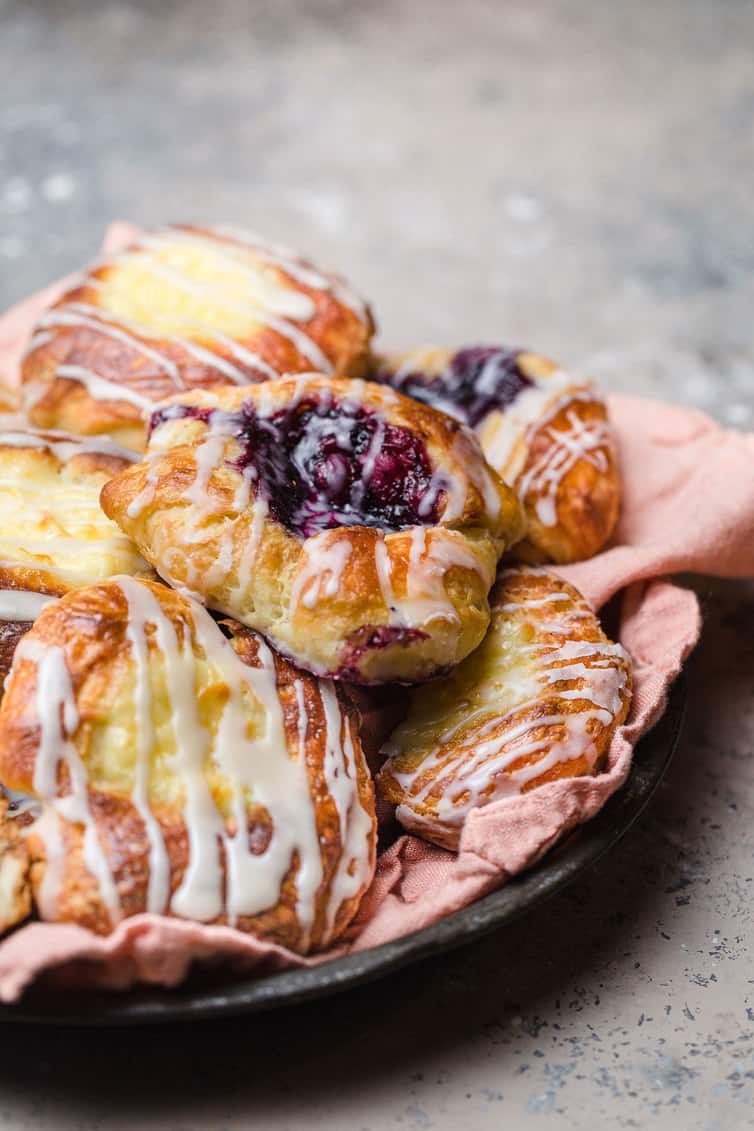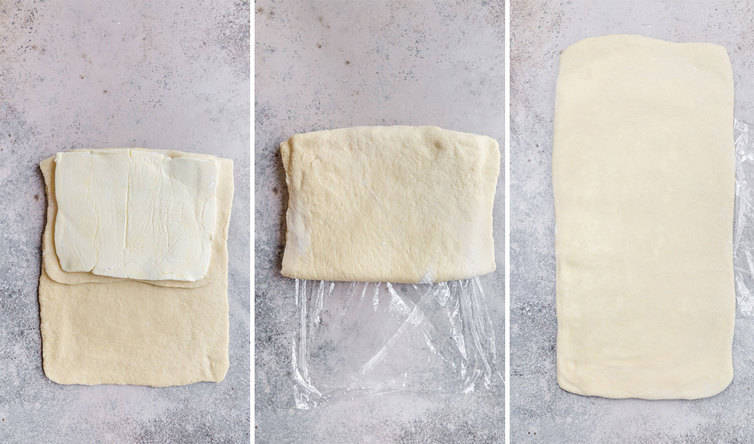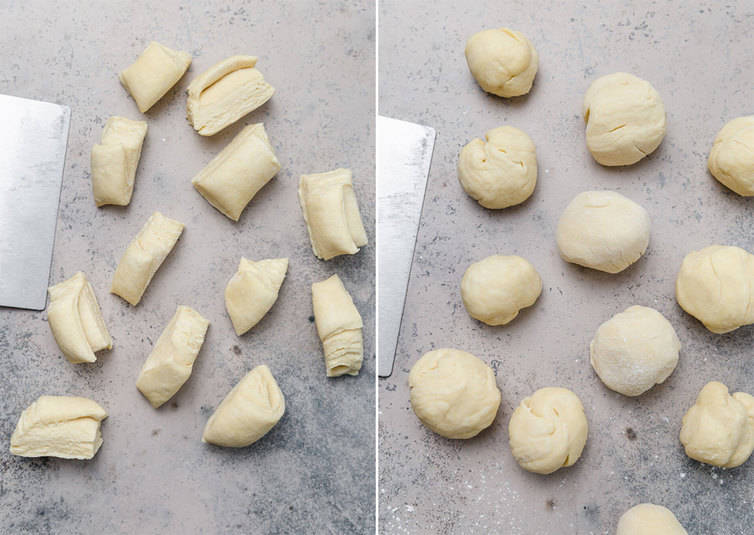Danish Pastries
These Danish pastries are made completely from scratch (no puff pastry here!), taste like they came straight from the fanciest of bakeries, and are easier than you’d think. The topping possibilities are endless; choose from cream cheese, fruit, chocolate, lemon curd, or a combination of those! A perfect baking project for overnight guests or special breakfast or brunch.

I know you might be intimidated by homemade pastries, but believe me when I tell you that they are SO doable and you will be absolutely thrilled when you get to sink your teeth into the final product. I’m going to walk you through the process below and there are very detailed directions in the recipe.
Let’s get going on these gorgeous Danish pastries!
The Butter Block
The most important component of the Danish pastry dough is the butter block. You’ll roll out two rectangles of butter and layer them into the dough before it gets rolled out and folded multiple times. This is what allows those gorgeous (and delicious!) flaky layers to develop.

Laminating the Dough
In order to take full advantage of the butter block we made above, we need to make sure there are layers upon layers of that delicious butter throughout the dough. In order to do that, we roll the dough out, place two layers of butter block between the dough, then fold it up and roll it out.


Then we fold and roll twice more, for a total of three times.
It may initially seem a little over the top, but once you bite into a finished Danish and see those flaky layers, you’ll be reaping the rewards big time!

Assemble the Pastries
After a long chill in the refrigerator, the dough is ready to be divided up and the Danish pastries assembled. I experimented with some different sizes and shaping methods and kept coming back to this simple, delicious, and classic circle. It’s virtually foolproof and has a perfect ratio of flaky pastry to filling.
First, working with one-third of the dough at a time, you’ll portion it out into 12 pieces each, and then roll them into balls…

Next, you’ll flatten them into discs, place on baking sheets and allow to rise for about 1 hour – they will puff up but will not double in size. Then it’s time to fill them!
Filling Ideas
My all-time favorite Danish flavor is cream cheese, so that’s obviously my recommendation, but most of the rest of my family love cherry, so I made some of those, as well ;-) If you’re looking for ideas beyond those basics, here’s a list to get you started:
- Cream cheese (recipe is below)
- Fruit jam, preserves, or canned pie filling
- Fresh fruit
- Lemon curd
- Chocolate ganache
- Nutella
- Feta and caramelized onions for a savory Danish!
Save This Recipe
You can also mix and match many of the combinations above! Cream cheese and berries or chocolate and orange would be fabulous together!

A Final Drizzle
Last but not least, we drizzle on a simple powdered sugar and milk glaze to make these Danish pastries really look like they just came from the bakery.
If you’d like, you could also sprinkle on some chopped nuts on top of the pastries before drizzling for a little crunch and texture contrast.

Recipe Success Tips
Some notes to help you make the best Danish pastries ever!
- When you make the butter block, be sure that your butter is on the cool side or it will be too warm to work into the dough. If it seems too soft when you start working with it, just pop it into the refrigerator to firm up before continuing with the recipe. Or, get it rolled into your rectangle then refrigerate your butter block rectangle until it firms up a bit before laminating the dough.
- You can tackle this recipe all in one day, or split it up into a more manageable two-day project. Simply leave the laminated dough in the refrigerator overnight and continue with the shaping and baking the next day.
- Feel free to experiment with different shapes if you’d like, but as I mentioned above, I had the most consistent success with these circular Danishes.
- These are best enjoyed the same day they are made for optimal flakiness and freshness, however, they will keep in an airtight container at room temperature or in the refrigerator for up to 3 days.
- Freezing the Dough: If you’d like to freeze all or part of the Danish pastry dough, you can do so after Step #11. Refrigerate for at least 2 hours, then wrap the portion you want to freeze in two layers of plastic wrap, place in a freezer-safe zip-top bag and freeze for up to 3 months. Thaw the dough overnight in the refrigerator, then proceed with the recipe as written.
- Freezing Assembled Pastries: To assemble the pastries and freeze before baking, complete the recipe through Step #17 (filling the pastries). Then, place on a baking sheet in a single layer and place in the freezer until they are completely frozen, at least 3 hours. Transfer the pastries to an airtight container or resealable freezer bag and freeze for up to 1 month. Bake from frozen (don’t forget the egg wash!), adding an extra 10 to 15 minutes to the bake time.
- Freezing Baked Pastries: To freeze already-baked Danish pastries, allow them to cool completely to room temperature, then wrap tightly in plastic wrap and place in an airtight container and freeze for up to 3 months. Thaw in the refrigerator overnight, then reheat in a 350-degree oven for 8 to 10 minutes, or until warmed through.

Watch How to Make Danish Pastry:
If you make these pastries and love them, I would so appreciate it if you would take a moment to leave a rating below. Thank you! ❤️️

Danish Pastry Recipe
Ingredients
For the Dough
- 2 cups (454 g) unsalted butter, divided
- 5½ cups (663 g) all-purpose flour
- ½ cup (99 g) granulated sugar
- 4½ teaspoons instant yeast
- 2 teaspoons salt
- 2 teaspoons vanilla extract
- 1½ cups (360 ml) milk
- 2 eggs
For the Cheese Filling
- 8 ounces cream cheese, at room temperature
- 3 tablespoons granulated sugar
- 1 egg
- ¼ teaspoon salt
For the Fruit Filling
- 1 cup fruit jam, preserves, or canned pie filling
For the Egg Wash:
- 1 egg white
- 1 tablespoon water
For the Glaze:
- 1½ cups (170 g) powdered sugar
- 2 tablespoons milk
Instructions
- Make the Dough: Cut ½ tablespoon off the ends of each of the four sticks of butter (for a total of 2 tablespoons).
- In the bowl of a stand mixer, whisk together the flour, sugar, yeast, and salt. Add the 2 tablespoons cold butter and work it in with a pastry blender or your fingers until no large lumps remain. Add the vanilla, milk, and eggs.
- Mix with the paddle attachment on low speed until a dough begins to form, then switch to the dough hook and knead until a cohesive, but quite sticky dough forms, about 5 to 7 minutes. The dough won't completely clean the bowl and will stick a bit at the bottom. (You can also complete this step in a bread machine on the dough cycle.)
- Scrape the dough into a ball, and transfer it to a floured work surface. Cover it with plastic wrap, and let it rest for 10 minutes while you prepare the butter.
- Make the Butter Block: Cut each stick of butter in half lengthwise, to make 8 long rectangles. On a piece of floured parchment or plastic wrap, line up 4 of the butter pieces side by side, to form a rectangle. Sprinkle lightly with flour, and cover with another piece of parchment or plastic wrap.
- Gently pound and roll the butter until it's about 6" x 9". The pieces may or may not meld together.
- Repeat with the remaining 4 pieces of butter. You should now have two butter rectangles, about 6" x 9" each.
- Laminate the Dough: Roll the dough into a rectangle 12" wide x 24" long. Place one of the butter pieces onto the center third of the dough. Fold one side over the butter to cover it. Place the other butter piece atop the folded-over dough, and fold the remaining dough up over it. Pinch the open ends and side closed.
- Turn the dough so a 12" side is closest to you. Roll the dough into a 10" x 24" rectangle. Fold each side into the center; then fold one side over the other to make a rectangular packet about 6" x 10".
- Dust the surface of the dough with flour, wrap it in plastic wrap, and chill in the refrigerator for 20 minutes.
- Remove the dough from the refrigerator, and again roll it into a rectangle about 10" x 24". Fold it into a packet as you did in step #9; it'll be about 7" x 12". Roll one final time, fold into a packet, and flour the dough lightly. Wrap loosely (but completely) in plastic, and chill it for at least 2 hours, or up to 16 hours.
- Make the Cheese Filling (if using): Combine all of the ingredients in a medium bowl, stirring until smooth.
- Assemble the Pastries: When you're ready to make pastries, remove the dough from the refrigerator, unwrap it, and cut off one-third. You'll work with this piece first; re-wrap and return the remainder to the refrigerator.
- Divide the dough into 12 pieces. Roll each into a smooth ball, then flatten the balls into 3" to 3 1/2" rounds, making the center thinner than the edges. You want to build up a slight wall of dough all around the circumference; this will help hold the filling. Place the rounds on a baking sheet lined with parchment paper or a silicone baking mat.
- Working with one-half of the remaining dough at a time, repeat the process; you'll finish with three baking sheets, each with 12 dough rounds.
- Cover the Danish lightly with greased plastic wrap, and let them rise for about 1 hour; they'll become slightly puffy. Towards the end of the rising time, preheat the oven to 400°F.
- Use your fingers to press the centers of the dough rounds as flat as possible, leaving the "sidewalls" puffed. Spoon a heaping teaspoon of filling into the well of each round.
- Make the Egg Wash: In a small bowl, whisk together the egg white and water. Brush the exposed edges of the pastries with the egg wash.
- Bake the Pastries: Bake the pastries, one pan at a time, until golden brown, 15 to 18 minutes. Remove them from the oven, and transfer to a wire rack to cool.
- Make the Glaze: In a small bowl, whisk the powdered sugar and milk to make a "drizzlable" glaze. If the glaze is too thick, add just a splash more milk at a time until the correct consistency is reached.
- Drizzle the glaze atop the pastries. Serve warm or at room temperature.
Notes
- Use very cool butter. Make sure the butter is extremely cold when you make the butter block. Even slightly warm butter won’t work into the dough. If the butter blocks seem too soft once they’re shaped, pop them into the refrigerator to firm up before continuing with the lamination process.
- This can be a two-day recipe. Don’t feel you need to rush through this recipe in one afternoon. You can tackle this recipe in one day or split it into a more manageable two-day project. Simply leave the laminated dough in the refrigerator overnight and continue assembling and baking the next day.
- Use different shapes. Feel free to experiment with different shapes of dough. As mentioned above, I had the most consistent success with circular Danishes, but trying something new is always fun!
- Enjoy right away. Baked Danish pastries are best enjoyed the same day they are made for optimal flakiness and freshness. However, they keep well in an airtight container at room temperature or in the refrigerator for up to 3 days.
- Freeze the Dough: If you’d like to freeze all or part of the Danish pastry dough before assembling and filling, follow the recipe through Step #11. Refrigerate for at least 2 hours, then wrap the portion of dough you want to freeze in two layers of plastic wrap, place in a freezer-safe zip-top bag, and freeze for up to 3 months. Thaw the dough overnight in the refrigerator, then proceed with the recipe as written.
- Freeze Assembled Pastries: To freeze assembled, unbaked pastries, follow the recipe through Step #17 (filling the pastries). Place pastries on a baking sheet in a single layer and freeze until they are completely frozen through, at least 3 hours. Transfer the pastries to an airtight container or freezer-safe zip-top bag and freeze for up to 1 month. Bake from frozen (don’t forget the egg wash!), adding an extra 10 to 15 minutes to the bake time.
- Freeze Baked Danishes: To freeze baked Danish pastries, allow them to cool completely to room temperature, wrap tightly in plastic wrap, and place in an airtight container or freezer-safe zip-top bag and freeze for up to 3 months. Thaw in the refrigerator overnight, then reheat in a 350-degree oven for 8 to 10 minutes, or until warmed through.
Did you make this recipe?
Leave a review below, then snap a picture and tag @thebrowneyedbaker on Instagram so I can see it!
(Recipe adapted from King Arthur Flour)
[photos by Ari of Well Seasoned]






Very delicious! Made over the weekend. Will definitely make again. I think I messed something up with the dough though, as when I baked them, a lot of butter leaked out onto the pan. And they’re flaky with lots of layers but not crispy. Would anyone know where I happened to go wrong? Still absolutely delicious!!
Initially wasn’t sure how well this recipe would work out as my dough was very liquid still when I reached the end of step 4 but not sure why and only realised this wasn’t right when I watched the recipe video. I had to add in quite a lot more flour to get the dough into a ball, but in the end when I reached the end of step 11, the dough was so nicely laminated with layers was easy to work with and tasted great! Really liked the instructions for the butter block and having the video included was super helpful.
I turned my dough into a mix of pineapple jam danish, cream cheese danish and pineapple cheesecake danish which all turned out lovely (I also made a few pain au chocolat). I used pineapple juice instead of the milk for the glaze and think it worked really well with these flavours.
I can NOT say enough good things about this recipe, from the step by step instructions to the pictures and tips. Everything turned out perfectly the first time and it is now, just as written, in our recipe box. Delicious and worth the time!
I would like to use ganache in these. Can it be baked in or is the suggestion only for a glaze? I was thinking cream cheese and ganache in each.
Thank you for your help
Excellent guidance and step-by-step process. They turned out delicious. They remind me of the ones my mom used to make many many years ago.
This recipe is daunting for amateurs new to the butter block, yet it was so well-explained, I felt at ease and like a brilliant pro with the results. The only step not described was while preparing the dough for the butter block, the parchment sheets of butter needed to go into the freezer in order to peel off in one intact rectangle, twice. The Family is loving this with a mixture of Lebanese Black Mulberry jam and cream cheese mix. Thank you once again for your clear explanations, this recipe is delicious & one to savour!
I’m a first time Danish baker so I wanted an easy recipe to try. I had plan to make these for my husband. I read through it several times to get an idea of what to expect. Then I baked them and it was easier than I expected. I do plan on making this again because it was super easy to follow.
I did a half recipe except a full recipe on the cheese filling and froze half. Used mixed berry preserves with some frozen berries mixed in after thawing. These turned out great. Made 18 vice 36. Dough started out very sticky but was surprised my marble rolling pin did not stick. Had two pans and rotated after 7 minutes, for an additional 7 or 8 minutes.Thanks for a great recipe. Hope to try some variations next time.
You never say what temp for the milk. I have my dough in the fridge. So fingers crossed i used the right temp…
Hi Jay! I’m sure they came out great, but ingredients in baking should be at room temperature unless stated otherwise. Happy baking!
Can I use active dry yeast? I don’t have instant yeast.
This recipe is excellent. It’s the perfect amount of dough to make (4) Danish Braids. The dough is beautiful to work with. I opted to let the braids do a cold rise in the fridge for 1 hour before baking and it worked out perfectly. Im eager to use it to attempt croissants.
First, I’ve made this recipe once and it was amazing! Thank you! My question is can this be refrigerated longer than 16 hours? I’d like to pre make the dough Friday morning and bake Saturday but that’s longer than the recommended timeframe. Thanks so much.
This recipe is the best! I’ve been making these for Christmas morning the past few years, and my husband says it’s his favorite tradition! Thank you for sharing such detailed directions!
Is it essential to take a 1/2 tablespoon off ALL ends of the four butter sticks? Or could I take one whole table spoon off one side of the butter sticks?
Thanks hoping mine turn out!!!
Absolutely the best thing I have ever tasted 👍🏻👍🏻👍🏻
Danish pastries are a delicious treat that are known for their flaky, buttery layers and sweet filling. They typically have a rich, slightly sweet flavor and a light, airy texture that melts in your mouth. contexto
Followed the recipe and they turned out amazing. I make them for my daughter who has food allergies and cannot have store or bakery items and she loves them.
This recipe for Danish pastries is awesome! What a flaky crust! I used the cream cheese filling plus guava paste. Could I freeze baked pastries?
Is there any instructions to make the dough if I don’t own a stand up mixer or a bread maker?
Amazing recipe…..I changed it up a bit though based on a professional baker friend. I used 1/2 butter and 1/2 crisco. The crisco gives the dough a lighter texture while the butter gives it flavor. Overall much easier to make than I had always thought. Thank you!
I made a few changes to this recipe but absolutely loved it
My danishes came out more like a biscuit. Do you know what might have went wrong?
This recipe is word for word the king arthur recipe. I understand that every danish recipe will be more or less the same ( you didn’t invent it after all!)- but copy/pasting the directions seems…sketchy for a food blog. At least describe it in your own words.
That was harsh even if it is true. I have used KAF for years and have made some recipes my own. It’s the ultimate compliment😉.
A lot of people don’t know about KAF so she was sharing. Have you ever shared and called it your own? I think everyone on the planet has shared something from someone else. No harm no foul. Don’t take it personal.
A compliment would be “This is the King Arthur recipe – I simply can’t beat it”. What they’ve done here is pure plagiarism, passing off someone else’s work as their own. Don’t make excuses for por ethics.
I followed this recipe to the T but I have a dairy allergy so I used vegan butter and dairy free “whole milk” that was soy. It turned out so well!
I cannot wait to make these. They look incredible! One question – could I assemble these the night before, pop them in the fridge, then take them out to rise and bake the next morning?
I made these danishes & they are exquisite. Great Recipe.
Although I’ve been baking for over 30 years, I had only tried Danish pastry once years ago, and it was a disaster. But I had great success this time around with this recipe – really glad I tried it. To shape the dough I used the rolled ball and flatten technique and also tried the rolled method used by Chelsea and both worked well. This success is just what I needed to try classic croissants! Thanks.
hi, i would like to try these but i have a question about the final rise (step 16) do they rise in the fridge or at room temp? thank you so much! :)
Hi Anne, They rise at room temperature. Enjoy!
I made these a few times now. They are unbelievably delicious. First recipe I tried for danish and it was a keeper for me. I now make them for a diner and family and friends. Thankyou!!
If I cut the recipe in half, what would be the correct measurements to roll out the butter sheets and the dough?
Hi Seth, I would make them half as big.
Great recipe! For shaping I rolled out my dough, used the lid of a large jar to cut out circles, let them rise for an hour, and then I used the bottom of a small jar to flatten the center. After that I spooned in the filling and baked as per directions. They came out looking just like the ones I buy at the store!
I would just like to comment to Chelsea, what you did with the lids and the glass jar, smart, what a great idea! I think I’ll do that too. Thank you. 😄
Mic drop, Chelsea! Thanks for posting this tip. I will do that when I make these. Can’t wait!